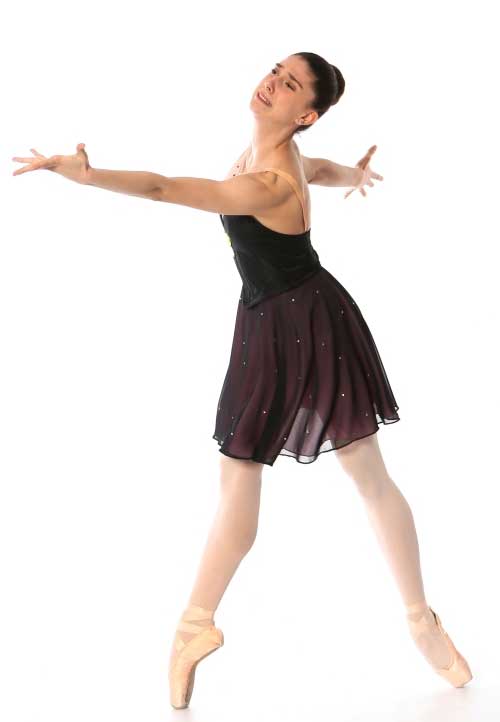Theater Jones Review
Dance Party
Ballet Ensemble of Texas proves its worth with A Celebration of Dance at Irving Arts Center.
by Katie Dravenstott
published Sunday, April 7, 2019

Peter Anastos\’ Night Crawlers
Irving — The young dancers of Ballet Ensemble of Texas (under the artistic direction of Thom Clower) commanded the expansive main stage of the Irving Arts Center over the weekend with A Celebration of Dance. The mixed repertoire performance delivered four ballets in various styles with a subtle range of emotions, but one thing remained constant. Spirits stayed high, and the energy endured.
Two traditional ballets bookended the production, with the contemporary works sandwiched in between. Lisa Slagle’s Festive Overture opened with the curtain rising on 16 dancers in white tutus with hints of color, designed by Patty Sayers and Sandra Tepera. Dmitri Shostakovich’s jubilant music matched the dancers’ radiant smiles. The complex vocabulary kept the dancers moving throughout with numerous pattern changes, but the performers remained strong. They glided through petit allegros and fouette sequences with ease and hit attitude turns with grace and joy.
Swinging in the opposite direction of the technical spectrum with a completely different mood was Tammie Reinsch’s Unity. Always one to challenge the strictly-trained, young ballet dancers with strong character pieces and contemporary vocabulary, Reinsch opted for less structured movement with spellbinding execution and fierce timing dynamics. Starting with an all-male ensemble wielding rain sticks, the piece added the ladies and transitioned between small and large groups with a lovely continuity. The rain sticks initially served as percussive instruments, but then turned into partnering props. A thin layer of haze caught the beams of the angled downlighting, adding to the mysterious aura. A staggering 33 dancers made up the final sections of the piece, but they filled the stage well.
The technical prowess of the company has never been in doubt, and while they exhibit fairly consistent performance qualities, it was perhaps Night Crawlers that stretched a small group of dancers the most. Choreographed by Peter Anastos, the founding director/choreographer of Les Ballets Trockaderos de Monte Carlo, it poked fun at the seriousness of ballet while still including complex vocabulary.
It took the almost-cliché structure of a contemporary ballet set to solo piano with the women in elegant cocktail dresses and gave it the comedic flare for which the Trockaderos became famous. Amidst the chaine turns and arabesques lie the reactions one wishes to express on stage, the underlying competition and diva culture, and backstage drama. Three ladies dressed in black short dresses with hints of shimmer and three men wearing black pants, dress shirts, and bow ties began on the stage with pianist David Dubiel in a gentle sway. A dark background covered in twinkling lights made the opening aesthetic vaguely reminiscent of Twyla Tharp’s Sinatra Suite.
It was a whirlwind of humor, switching back and forth between the usual presentational performance of classical ballet and authentic reactions with physical comedy. Women partnered men, jealousy popped up during a pas de trois, and feet flexed in the wrong places. The dancers almost ran into the piano, took wrong exits, and traveled across the stage in a decidedly un-balletic manner. Cartoonish partnering, similar to some early Pilobolus choreography, evoked even more laughter from the audience. Dubiel even joined in the comedic action, as he bumbled through pages of sheet music and even enjoyed a snack break while a frenzied section of the Chopin music continued to play.
Precisely timed to his magnificent playing, the dancers never once let their performances slip. Exaggerated facial expressions and postures were a vital part of the choreography and a key to the piece’s success. They even managed to dig up the subtle nuances in performance quality that are typically one of the last things to develop in budding ballet professionals. Allison Brueggeman especially shone in her overly dramatic sadness and anger.
A Romantic ballet that still defied some of the era’s traditions closed the evening with a solid lineup of ensemble and solo moments. Bournonville’s Napoli from 1842 gave the dancers another challenge, not only with the Danish choreographer’s specific technique and style, but with the intense energy and technical choreography of the ballet’s wedding celebration. With a colorful backdrop and equally vibrant costumes, the segment (which contained no narrative structure) gave all dancers a time to shine with the various sections and tempos. A lively tarantella which included folk dance maneuvers provided a nice reprieve from the ballet vocabulary, and Ryan Nemmers delivered stunning control in his allegros in his solo moments.
It’s difficult to nail down what the most impressive moment of the evening was. Whether it’s the unified dancing, stellar ensemble precision, or the sheer number of dancers on stage rising to a level of excellence usually only attained by a select few, BET proved its caliber and distinct place in North Texas.